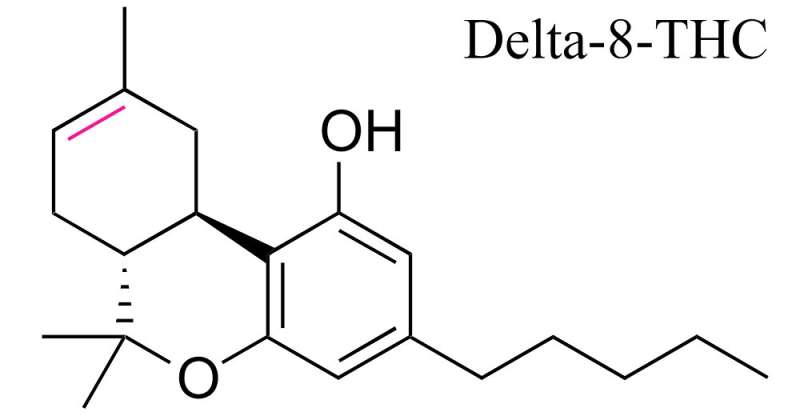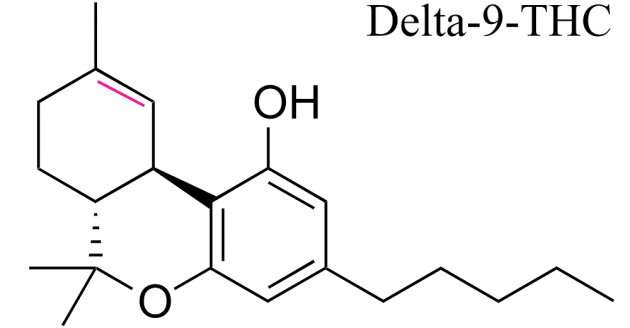Both types of THC get you high—so why is only one illegal?

One is an illegal drug found in marijuana while the other is marketed as a safe herbal alternative. But the claimed differences between them aren’t backed by science, a group of UConn researchers report on Nov. 1 in Drug and Alcohol Dependence.
Tetrahydrocannabinol, or THC, is the psychoactive compound produced by cannabis plants. The federal government lists Δ9 -THC (pronounced delta-9-THC) on the Schedule 1 list of dangerous drugs with no accepted medical use. But other versions of THC that differ only by the location of a double bond, such as Δ8-THC, remain quietly quasi-legal on the federal level.
The legality differences between the various versions of THC are causing conflict between the hemp and cannabis industries. There is also potential for harm to consumers. Although Δ8-THC is viewed as an herbal extract of hemp, many manufacturers use solvents and chemical processes that can leave harmful residues in the product, and there are no standards for purity or safety.
Because there are no limits, some products contain ridiculously high levels of ∆8 and other THC variants that could potentially cause harm due to the sheer dosage. And states do not agree on its safety or legality. Some states, such as Connecticut, have made Δ8-THC as controlled as Δ9-THC, while in others it remains legal. Cannabis producers allege the distinction is giving rise to unfair competition between the hemp and marijuana markets.
If regulating Δ9-THC as an illegal drug is based on the fact that it has physical and psychoactive effects, then the first step to rational regulation of Δ8-THC would look at whether it, too, has those effects. And people who have experience with both say it does; most agree the effects of Δ8 are similar to Δ9.
UConn School of Nursing professor and Center for Advancement in Managing Pain director Steve Kinsey, graduate student Olivia Vanegas, and their colleagues in UConn Chemistry and local startup 3BC Inc decided to test that in mice. Research done in Japan in the 1980s had shown that Δ8-THC produced the same effects in mice as Δ9-THC. Kinsey and Vanegas reproduced that work and found it to be true: the mice given Δ8 became lethargic, their body temperature dropped, and they became cataleptic, meaning the researchers could put the mice in unusual positions and they’d stay like that for several seconds, which is common in THC-treated mice, but not normal mice.
Then the researchers took it a step farther, blocking the mice’s THC receptors. Blocked mice had no reaction to Δ8-THC, making it clear that Δ8 interacts with the same receptors as Δ9-THC.
Then the researchers took a group of mice and gave them Δ8-THC twice a day for five days. Over time, the mice became desensitized to it. And when they were then given the THC blocker, the mice acted like they were in withdrawal.
Finally collaborators at RTI International ran an experiment “asking” the mice how the drug felt. First they trained the mice to go to a specific spot for a reward if they were dosed with Δ9-THC. After the training, the mice were dosed with Δ8-THC. Unsurprisingly, they went to the same reward spot as when they were dosed with Δ9.
“So they’re telling us the same thing people buying the stuff in gas stations tell us: Δ8 feels like THC,” Kinsey says.
Chemically, it’s unsurprising. Molecules as similar as Δ8- and Δ9-THC usually (though not always) act the same in the body. But legally it causes a lot of complications.
The distinction between Δ8- and Δ9- originally came about from the congressional Farm Bill covering hemp growing and sales. Hemp is defined as a cannabis plant that has less than 0.3% Δ9-THC by dry weight. Anything that has more concentrated Δ9-THC than that is considered marijuana. Additionally, the Farm Bill said anything else naturally present in the hemp plant is legal. That includes Δ8-THC.
“It’s creating a fight between marijuana and hemp growers,” says John Harloe, an attorney on Colorado’s THC taskforce. Products classified as marijuana “must be sold through dispensaries and pay high taxes, while hemp producers can sell essentially the same product but without the same regulations, due to the ambiguity in the Farm Bill,” Harloe says.
Harloe is bringing Kinsey and Vanegas’s paper to the Colorado taskforce to inform the discussion. The taskforce is trying to create appropriate regulation that will address the different chemical variations of THC and guard public safety without crippling the hemp industry. The paper is particularly valuable because there is so little research done on THC and its intoxicating effects, due to federal rules.
Source: Read Full Article

